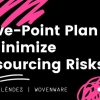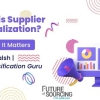When a function or even a full department is outsourced to a managed service provider (MSP), the scope of work, requirements and service needs can at times be hard to nail down, especially as the relationship with the MSP evolves over time and the needs of the business evolve. This is particularly true in the case of IT Managed Services – an area with frequent need for outsourcing due to resource constraints and/or technical expertise and an area where it is critical that services continue uninterrupted.
When evaluating an outsourced service model, there is certainly a balance between having a supplier “nickel and dime” for every task they take on and having a bundled, flexible solution to meet your service needs. Similar to building or buying a home, a strong foundation is critical; in order to lay the proper foundation of a successful MSP relationship you first have to ensure your go-to-market strategy and Request for Proposal (RFP) documentation clearly define the organizational needs and expectations.
Draw the Blueprint and Build the Frame: Scope
If you are looking to outsource a function or evaluate potential suppliers to replace your current MSP, it is important to understand the scope of services and the base level of coverage necessary in the relationship - meaning what is actually being done by your vendor on a day-to-day basis. This will set the stage for defining the majority of the scope. Beyond the routine items, also consider the necessary “fire and flood protection”- the more extreme scenarios that your organization may encounter and the MSP’s expected role in the cases. This may be easier said than done. Think about your organization’s security function for instance: the bulk of the work may be made up of day-to-day management, e.g. patches, upgrades, firewall management, etc., but there will also be a component of triage or ramped-up needs if a breach or security threat is detected.
If you’re looking to go to market with an existing supplier in place, start with reviewing the current agreement, any change orders that have come into play or ancillary SOWs. These can help you to determine what the current supplier considers as core scope versus more project based work that requires additional support or fees. Also review past relationship issues, quarterly business reviews and the level of KPI/metrics tracking in place today – this will allow you to understand your current service levels and identify gaps or areas that should be improved through the sourcing event.
While it is important to capture the day-to-day scope within an RFP, it is also important to understand the less common service offerings. If you can’t properly articulate these services, it could result in bidders providing pricing aligned to degraded service levels (the metaphorical cheap materials, bare-bone home finishes) or pricing that is full of assumptions and padding because the bidders don’t truly understand your needs (the assumed highest-end materials/finishes).
An important step in including these types of services in an RFP is knowing what they are and what your contending supply base considers “above and beyond.” You can start with your current provider – they are likely to cast a wide net in terms of the value-add services they provide to further drive home the value they deliver to you as their customer. Ask key questions to learn what they would consider out of the ordinary in terms of service from the current MSP, how involved the MSP was in those incidents, if additional fees were assessed and if the need of the organization warrants having the same or increased level of services in such scenarios.
It’s important to understand service delivery and needs from both the supplier and stakeholder side – many suppliers see portions of their service as being extraordinary, whereas the stakeholder may see them as the minimum required to properly deliver the services. To that end, ensure you allow for time in the RFP process for supplier questions or even discussions with key stakeholders to ensure there is a full understanding of service needs. By providing stakeholder feedback on questions and discussions to all bidders, you can ensure that each is working from the same assumptions and reinforce closer to apples-to-apples proposals.
Inspection and Appraisal: Data and Metrics/SLAs
For outsourcing IT functions, it is important to define what success looks like (what will the inspection cover/what are acceptable results) and how you’ll measure the MSP on the level of service they are providing (what’s the appraised value/how do you measure the value the MSP delivers). For example, if you are looking to outsource your help desk, you’ll want to measure and define Service Level Agreements (SLAs) around how quickly incidents are being resolved (with a focus on the incidents with critical impacts on the business), if incidents are able to be resolved during the initial call, overall customer/end user satisfaction levels, along with a number of other KPIs and metrics. Each service will have its own set of necessary metrics and service expectations that should be defined at the priority level. If your IT group’s SLA level expectations are known, outline those expectations within the RFP. If they are unknown as the service is new to outsourcing or expected level of service can’t be defined, gather the various SLA proposals by priority for any known/defined metrics and ask bidders to supplement with the other SLAs they are willing to include. SLAs can be approached similarly to pricing by asking for proposals, reviewing the options with your IT stakeholders and negotiating to the right levels based on what the market is offering.
Aside from SLA measurement, ensure your provider is tracking the different areas of support they provide. If we think back to the help desk service example, you will want to understand what applications are driving incidents and track/measure supplier performance at the application level as well. This allows your organization to see if there are gaps in the supplier’s expertise within a certain application, i.e. those incidents may go unresolved for longer and target root cause analysis and actions to stop pervasive issues when incidents reoccur. Ask questions within the RFP to understand how SLAs are tracked, measured and reported back, along with the proposed remediation plans if SLAs are not met.
Mortgage Structure and Rates: Pricing
Similar to purchasing a home and structuring your mortgage (i.e. principal amount, length of loan term, fixed vs. adjustable interest rate, taxes and insurance) you will need to ensure visibility into all aspects that would or could affect the total cost of service with the chosen MSP. Your RFP should also be structured to understand what metrics drive pricing for each supplier, e.g., is the service cost resource-based, ticket-based, device-based and how are they structuring their proposal based on this along with any assumptions made around volumes. Models that leverage full time resources are likely to give the most flexibility – but consider your true service needs as this is almost always the most expensive option given that you are paying for full time support whether it is necessary or not. If you are looking at a resource-based model, also consider your expectations around onsite, onshore and offshore – what tolerances are in place and what degree of “high-touch” or deskside support is required – and define those expectations within the RFP. The trend has certainly been to leverage remote support given the technology changes that make this possible for a variety of different monitoring, maintenance and support options to be supported almost exclusively offsite.
If you are looking at pricing based on a per unit/volume-based model, you will need to have a good idea of the volumes you anticipate, e.g., knowing your hardware inventory for monitoring, knowing your current help desk volumes by criticality and incorporating these volumes into the RFP. These types of metrics should be available if you have an MSP in place today, but tend to be tracked less accurately when supported by in-house staff. If accurate volumes are not available, be prepared to define some range of potential volumes and to work within an engagement structure that has a true-up or rightsizing period to fit your actual volumes. Also look to understand the pricing model in place during the ramp up or knowledge transfer period and if future years of the engagement would have a backing down/reduction in resource or volume needs – this is occasionally proposed if the MSP anticipates being able to gain efficiencies as they become more familiar with your environment and organization.
As you construct the various scope, SLA and pricing structures within your RFP, find a structure that allows suppliers enough flexibility to optimize their service structure, while providing enough guidance and definition around service expectations and scope to ensure the service proposal is aligned to your organization’s needs. In all cases, whether exploring supplier transition or moving from in- to out-sourced, ensure your sourcing process timeline leaves a large runway for implementation (i.e., you need time to “build the house”). Consider the timelines to get new resources onboarded, understand your environment, ensure knowledge transfer and establish the tracking and reporting structure negotiated through the RFP. Managed services will almost never be delivered in the exact same way across suppliers – what is important is to understand the goals of the service, how it is ensured and what that means from a performance management and cost structure perspective.









